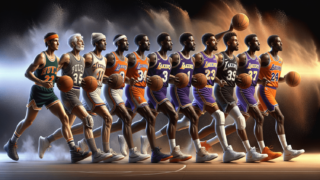
Is Basketball a Winter Sport?
Written by: Basketball Universe
Last updated:

As the air turns crisp and the first snowflakes begin to fall, a question that has echoed throughout the ages resurfaces: is basketball a winter sport? In this fun yet professional exploration, we delve into the very roots of basketball, from its inception by Dr. James Naismith in a cold Canadian winter to the dynamics of the modern game influenced by climate and passionate players alike. Join us on this exciting journey as we uncover the history, the facts, and the opinions that have shaped the debate surrounding the frosty classification of our beloved sport.
Is Basketball a Winter Sport?
Technically, basketball is considered an indoor sport rather than a winter sport since it can be played year-round indoors. However, it has strong associations with wintertime due to the NBA season traditionally running from October to April and college basketball’s March Madness tournament occurring in the winter to early spring.
The Birth of Basketball: A Winter Game
In December 1891, Dr. James Naismith, a Canadian physical education instructor, invented the game of basketball as an indoor sport that could be played during the harsh winter months in Massachusetts. Looking for a way to keep his students at the International YMCA Training School engaged in athletic activities, Naismith devised a game which combined elements of soccer, lacrosse, and rugby. Little did he know, his invention, which saw its first game played with a soccer ball and two peach baskets, would eventually capture the hearts of millions worldwide.
The NBA Season: Winter’s Main Attraction
The National Basketball Association (NBA) was founded in 1946, and its season structure has been influential in associating basketball with winter. The NBA regular season typically runs from late October to mid-April, with the playoffs extending through June. The league comprises 30 teams that play an 82-game regular-season schedule, followed by a postseason tournament. The timing of the NBA season, with games played throughout the winter months, contributes to the assumption that basketball is a winter sport. However, it is important to note that teams play indoors, so the sport can be enjoyed year-round.
College Basketball: March Madness and Winter
College basketball also contributes to the perception of basketball as a winter sport due to the famous “March Madness” NCAA tournament. The NCAA Division I Men’s Basketball Tournament runs from mid-March to early April, featuring 68 college teams competing for the national championship. March Madness focuses the nation’s attention on college basketball during the winter months, once again connecting the sport to this season.
High School Basketball: Aligning with Winter
High school basketball often follows a similar timeline to the collegiate level, with most schools beginning their seasons in November or December and ending with regional or state championships in February or March. High school sports typically follow seasons (fall, winter, and spring), and basketball occupies the winter slot in many areas. This means that for many young athletes, basketball is indeed a winter pursuit.
International Basketball: A Global Perspective
Basketball has become a popular sport around the world and is played at various professional and amateur levels. The international governing body for basketball, FIBA, organizes competitions such as the FIBA World Cup and the Olympic Games, which take place every four years in different seasons. This broadens the concept of basketball as a sport for both winter and summer enthusiasts. Additionally, various countries and regions have their own basketball leagues, with seasons that often align with the NBA, further solidifying the connection between basketball and winter.
The Indoor Advantage: Basketball’s Year-round Appeal
One essential characteristic of basketball that distinguishes it from other sports is that it can be played indoors all year long. Many schools, colleges, and recreational centers have gymnasiums, which are equipped for basketball, making it a popular choice during the winter when outdoor sports may not be feasible. However, its indoor playability also means that basketball can be enjoyed year-round, in virtually any weather, so it doesn’t exclusively belong to the winter category.
Outdoor Basketball: More than Just Winter
In contrast to the winter-season emphasis of professional and scholastic basketball, pick-up games, streetball, and summer leagues highlight the fact that basketball can be enjoyed in the great outdoors during warmer months. The accessibility of outdoor basketball courts and blacktops across the nation expands the game’s appeal beyond the winter months, demonstrating basketball’s versatility and adaptability as a sport for all seasons.
Climate Impact: Different Countries, Different Seasons
In countries with temperate climates or those closer to the equator, the concept of “winter sports” may not apply at all, as outdoor temperatures remain conducive to year-round play. In these areas, basketball might be viewed as a staple of the local sports landscape regardless of the season.
NBA Globalization: Expanding Beyond Winter
Recognizing the worldwide appeal of basketball, the NBA has made considerable efforts to globalize the sport in recent years. Hosting regular-season games and preseason exhibition matches in countries such as China, Japan, and Mexico, the NBA shares America’s favorite indoor game with international fans, further challenging the notion that basketball is limited to the winter months.
In Conclusion: A Sport for All Seasons
Although basketball has its roots as an indoor winter activity and features league structures that play predominantly during the winter months, its versatility and appeal extend far beyond this season alone. From pick-up games on outdoor courts in the summer to professional leagues worldwide, basketball consistently proves that it can be enjoyed year-round. So, while we may consider basketball a winter sport based on historical and competitive contexts, never forget that the game is just as exhilarating during the other seasons of the year.
A Brief History of Basketball in the Olympics
The widespread international appeal of basketball has also solidified its presence on the Olympic stage. Interestingly, basketball was introduced as an Olympic sport at the 1936 Summer Olympics in Berlin, Germany, rather than in the Winter Games. Since then, basketball has become a mainstay in the Summer Olympics, attracting top talent from around the world and showcasing the game to an even broader international audience. This Olympic showcase of basketball during the summer months further supports the notion that basketball is not exclusively a winter sport.
Women’s Basketball: Another Layer of Versatility
Women’s basketball, both at the professional and amateur levels, has also contributed to basketball’s wide-ranging seasonal appeal. The Women’s National Basketball Association (WNBA) season typically runs from May to September, which is opposite the NBA season. The scheduling of the WNBA showcases basketball as a sport that can be enjoyed in warmer months as well. Furthermore, women’s college basketball programs follow similar timelines as their male counterparts, adding to the overall association between basketball and the winter season on the collegiate level.
Indoor and Outdoor Variations: Fun for Everyone
Basketball is a versatile sport that offers a variety of options to suit different preferences and skill levels. Fans of the game can choose from several variations that highlight the sport’s year-round accessibility. Here are some popular examples:
3-on-3 Basketball
3-on-3 basketball has grown into an increasingly popular version of the game, featuring smaller teams and a faster pace. The half-court format is conducive to both indoor and outdoor play. Its inclusion in the 2021 Tokyo Olympics demonstrates that this alternate version of the sport can also thrive outside of the winter season.
Streetball
Streetball, commonly played on outdoor courts like those found in city parks, is another illustration of basketball’s adaptability beyond the traditional indoor court. Streetball encourages creativity and flair, with players often showing off impressive ball-handling skills and unorthodox moves. Typically played without a strict set of rules, streetball reflects the game’s flexibility and year-round appeal.
Wheelchair Basketball
Wheelchair basketball is an inclusive variation of the sport, ensuring that individuals with physical disabilities can participate in and enjoy the game. Wheelchair basketball often follows a similar seasonal schedule as able-bodied leagues and can be played both indoors and outdoors during various times of the year.
Destinations for Basketball Travelers
Whether you’re looking to play or watch basketball, there are numerous destinations around the globe that cater to enthusiasts of the sport. From iconic venues like New York City’s Madison Square Garden or Los Angeles’ Staples Center to world-renowned outdoor courts like Venice Beach or Rucker Park, basketball enthusiasts can find year-round opportunities to immerse themselves in the sport they love.
Frequently Asked Questions
Curious minds often seek answers to various questions surrounding the category of basketball as a winter sport. To help quench your thirst for knowledge, we’ve prepared an FAQ section that covers some of the most common inquiries related to this intriguing topic.
1. Why was basketball invented as an indoor sport?
Dr. James Naismith, the inventor of basketball, sought to provide his students with a physically engaging activity during the winter months in Massachusetts. Therefore, he designed basketball as an indoor sport that could be played in a gymnasium regardless of the weather outside.
2. Why does the NBA season occur during the winter?
The NBA season takes place during the winter primarily due to scheduling and historical factors. Many basketball leagues worldwide have followed similar timelines, creating a strong connection between basketball and the winter season.
3. Can basketball be played outdoors during the winter?
While basketball is typically an indoor sport, it can also be played on outdoor courts year-round, including during the winter in milder climates. However, weather conditions such as snow, ice, or extreme cold may make it challenging or unsafe to play outdoors.
4. Is basketball an Olympic winter sport?
No, basketball is not considered an Olympic winter sport. Basketball first appeared in the Olympic Games in the 1936 Summer Olympics and has remained a part of the Summer Games since then.
5. What are some examples of true winter sports?
True winter sports include activities such as ice hockey, alpine skiing, snowboarding, figure skating, and curling, which are typically played or performed in colder, snowy environments or on ice.
6. Can I play basketball indoors during other seasons?
Yes, basketball can be played indoors year-round, making it a versatile sport enjoyed during any season.
7. Is college basketball only played in the winter?
While the winter season predominantly hosts college basketball games, particularly the NCAA tournaments, many schools also have preseason schedules that begin in the fall or summer basketball camps and training programs.
8. Is women’s basketball also considered a winter sport?
Similar to men’s basketball, women’s basketball can also be considered a winter sport due to its season structure. However, women’s basketball enjoys an annual summertime presence with the WNBA season, and it can also be played indoors or outdoors year-round, just like the men’s game.
9. When is the best time of year to play basketball?
As a versatile indoor/outdoor sport, basketball can be played and enjoyed throughout the entire year, making the “best time” purely subjective and dependent on individual preferences.
10. How can I find an indoor basketball court near me?
You can locate indoor basketball courts near you by searching online or using smartphone apps tailored to discover sports facilities in your area. Additionally, local schools, colleges, and community centers often have gymnasiums with basketball courts open for public use.
11. Is participating in a summer basketball league a good idea?
Yes, joining a summer basketball league is an excellent way to stay active, improve your skills, and enjoy the sport during the warmer months. Such leagues cater to various skill levels, ensuring appropriate competition for anyone interested in playing.
12. How can I prepare to play basketball during different seasons?
Depending on the season and the climate in your area, adjusting your clothing and gear, as well as staying hydrated and properly warmed-up, are essential factors for comfortable and safe basketball play. Outdoor play during cold weather may require an additional focus on personal safety by staying alert for slippery surfaces and dressing in warmer layers.
13. Are there basketball training camps available during the offseason?
Yes, basketball training camps, typically designed for high school and college players, are often held during the offseason. These camps provide opportunities for skill development, specialized training, and strength and conditioning work, helping players stay in shape and improve during the months away from their regular basketball schedule.
Featured Posts
- No pillar pages found.




